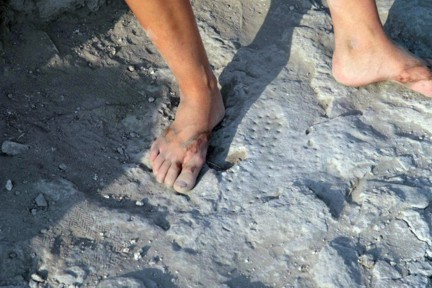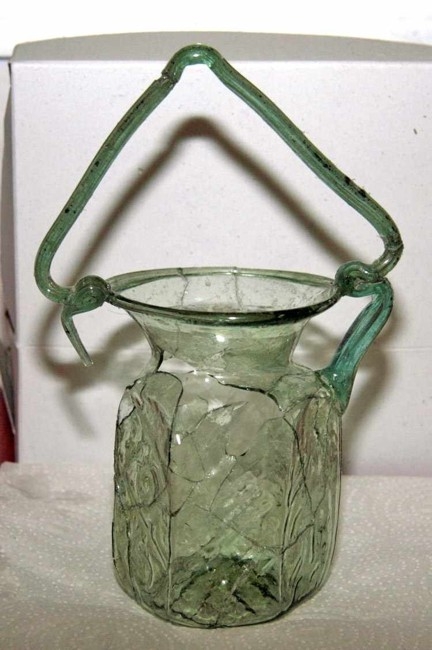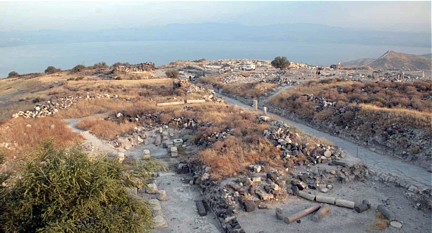Descubren la huella de una sandalia romana en un muro de las ruinas de Sussita (Israel)
Foto: University of Haifa
Arqueólogos que están excavando en las ruinas de la antigua ciudad helenístico-romana de Sussita (Hipos), junto al Mar de Galilea, han descubierto en un muro una misteriosa huella; la de una sandalia con clavos de un legionario romano. Se ignora si la huella fue dejada por un soldado romano que quizá participó en la construcción de esa muralla, o de alguno que dejó de prestar su servicio militar y conservó ese calzado para trabajar como albañil, informa hoy el diario Haaretz, que se remite al director de las excavaciones, Arthur Segal.
Antes del hallazgo, el único testimonio arqueológico similar se encontró en el Muro de Adriano, en Gran Bretaña.
El misterio en torno de la huella hallada en el muro de Sussita, construida hacia el tercer siglo antes de Cristo y destruida por un terremoto en el 749, se debe a que, según el arqueólogo, los proyectos de construcción en Israel estaban a cargo de sus ciudades, y no participaban en ellos los conquistadores romanos.
Los arqueólogos encontraron el año pasado una inscripción escrita por dos residentes de Susita al terminar su servicio militar, lo que llevó a los investigadores a pensar que ese podría ser también el caso del que dejó la huella de la sandalia.
La huella fue encontrada durante las excavaciones alrededor de la fortificación romana que circundaba a la ciudad.
Los griegos llamaron a la ciudad "Hipos" (Caballo) pues fue enclavada sobre una colina que semeja el lomo de un equino. Los romanos le dieron el nombre arameo de Sussita, voz que también designa a ese animal, y que se conserva el hebreo moderno, "sus".
Foto: University of Haifa
La mayor parte de las construcciones en Sussita, probablemente fundada por el rey seléucida Antiochus Epifanes -aliado de Grecia y enemigo de los judíos de aquella época- data del período romano.
Fuente: EFE / Diario de Mallorca, 15 de agosto de 2007
Enlace: http://www.diariodemallorca.es/secciones/noticia.jsp?pRef=
1623_18_285346__Ciencia-Descubren-huella-sandalia-romana-muro-ruinas-Susita
Hippos (Sussita)
Photo Gallery I
Photo Gallery II
Photo Gallery III
Photo Gallery IV
Hippos2003ReportPhotos (29 images)
FinalDrawings2003 (21 images)
(2) Ancient Footprint Uncovered at Hippos (Sussita) Dig
Archaeologists have discovered a footprint made by the sandal of a Roman soldier in a wall surrounding the Hellenistic-Roman city of Hippos (Sussita), east of the Sea of Galilee. The footprint was discovered during this eighth season of excavation, led by Prof. Arthur Segal from the Zinman Institute of Archaeology at the University of Haifa in conjunction with archaeologists from the Polish Academy of Sciences and Concordia University in St. Paul, Minnesota. "This rare footprint, which is complete and well preserved, hints at who built the walls, how and when," said Michael Eisenberg of the Zinman Institute at the University of Haifa.
Foto: University of Haifa
The print, made by a hobnailed sandal called caliga, the sandal worn by Roman soldiers, is one of the only finds of this type. The discovery of the print in the cement led archaeologists to presume that legionnaires participated in construction of the walls.
The excavations of this section of the southern city walls also revealed towers and well-protected structures for positioning weapons such as catapults and ballistae built into the wall.
The ancient city of Hippos (Sussita), at 350 meters above sea level, overlooks the Sea of Galilee. The city was established during the period of Seleucid rule. It flourished during the Roman and Byzantine periods until it was destroyed by an earthquake in the year 749. Hippos (Sussita), together with Beit Shean and other cities east of the Jordan River, formed the "Decapolis", the area in which Jesus performed most of the miracles described in the New Testament. "The remains of Sussita, its view of the Golan Heights and the Galilee and its historic significance in Christianity, have made it one of the most attractive sites in northern Israel," said Prof. Segal.
This seasons excavations have uncovered additional, important finds: the citys colonnaded street, some 240 meters long; a magnificent, marble-paneled bathhouse; and a glass bottle with an embossed face. On the final day of the dig another unusual find was uncovered: part of a white marble statue, a hand holding a staff, apparently part of a Greek god. The archaeologists are hopeful that during the next digging season they will find other pieces of the statue which is estimated to be 2 meters high.
Link: http://www.newswise.com/articles/view/532736/?sc=rsln



0 comentarios